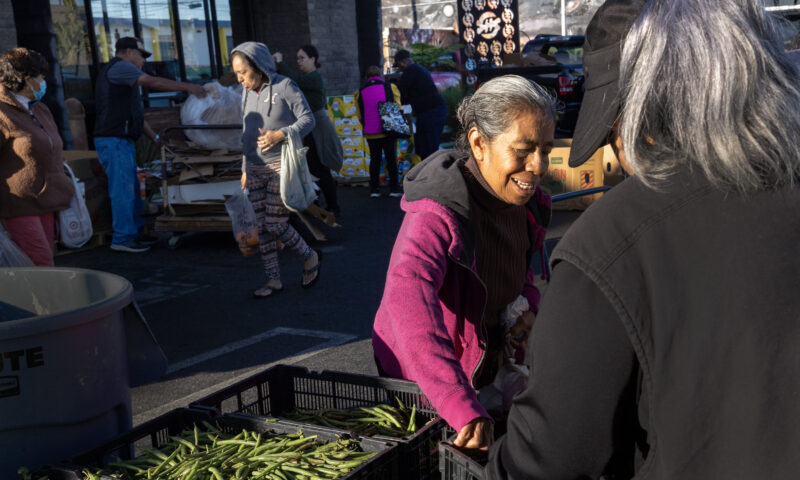Column - State of Inequality
California Learned During the Pandemic How to Rapidly Cut Poverty, But It Was a Temporary Fix
With the end of direct cash payments, poverty levels are moving up.

The focus on the blistering effects of poverty in California can sometimes obscure a larger truth: Poverty rates overall have been declining, not growing — and for decades now.
“You do have to squint a little to see it,” said Caroline Danielson, interim vice president of research at the Public Policy Institute of California. “There’s a lot going on there, and it has not been just a steady decline.”
Join our email list to get the stories that mainstream news is overlooking.
Sign up for Capital & Main’s newsletter.
Nevertheless, the institute’s long-term findings are clear. Where at least a quarter of Californians lived in poverty in the early 1990s, that figure has been below 20% for most of the 2000s — and as of early last year, it stood at 13.2%, using what’s known as the California Poverty Measure.
Almost all of that reduction, experts say, has to do with advances in social safety net programs designed to lift families out of poverty. No surprise, then, that the 2023 California poverty rates actually represent a rise since 2021, as the numbers coincide with the end of several federal pandemic-era programs that included direct cash assistance to households.
“The pandemic just revolutionized how we think about poverty and policy,” Danielson said. “We’re still trying to learn those lessons and see what we want to take away from that.”
* * *
Researchers have tried for decades to get an accurate handle on poverty in California. The standard national methodology fails because it doesn’t account for things like food and housing assistance when calculating household resources — and on the other hand, it doesn’t account for the state’s high cost of living, which often offsets that assistance.
The California Poverty Measure, or CPM, is a collaboration between the institute and the Stanford Center on Poverty and Inequality. It represents an effort to fill the gaps in federal reporting and provide a more clear-eyed picture of poverty in the state.
As a result, the California Poverty Measure generally runs well higher than federal estimates for California, and higher than the national average. For example, Danielson recently noted that in the first year the CPM was used, 2011, the resulting poverty rate of 21.7% was five points higher than the official state figure.
That’s primarily because the state’s cost of housing, though it varies by county, makes it harder for lower-income families to stay out of the hole. But even using the more inclusive CPM, the past two decades have been marked by a drop in poverty overall.
While the pandemic exacted a heavy toll on workers and businesses, federal relief efforts told a different story in terms of poverty. While the official poverty rate rose beginning in early 2020 (remember, it does not compute tax credits or food assistance), the CPM rate actually declined dramatically, from 16.4% in 2019 to 11.7% in the fall of 2021.
“We estimate that regular and expanded safety net benefits [during the pandemic] cut poverty nearly in half in the fall of 2021 and by more than 60% in early 2023,” Danielson wrote. The 4.7% reduction in poverty rate, she told Capital & Main, was equivalent to the progress that had been made over nearly a decade before that.
A few years removed from the worst of COVID-19’s initial damage, those pandemic lessons are still being mulled. One of them, researchers say, is that the government has a substantial ability to alleviate poverty if it chooses to enact policies in that direction.
Over the past couple of decades, the federal Earned Income Tax Credit has helped millions by providing tax breaks to lower- and moderate-income families who qualify. (California has a smaller state EITC as well.) Danielson said that not only has the credit put more money directly in the pockets of those families, but studies indicate it has incentivized work, particularly for single mothers who can benefit from the program.
But it was direct assistance — both federal stimulus payments and enhanced unemployment insurance — that led to the more dramatic drop in California poverty rates during the pandemic. According to research by the institute, the stimulus payments kept 1.7 million of the state’s residents out of poverty, while the unemployment insurance helped another 1 million stay out of poverty.
State assistance programs like CalFresh and CalWORKs continue to do important work to alleviate food insecurity and help families pay for some household costs. The state’s expansion of Medi-Cal to include all qualifying residents regardless of their immigration status is another lifeline to working poor families who can’t afford to see a doctor.
The state’s poverty rates will still run ahead of the national average, “and it’s really just that those additional safety net benefits are offset by the high cost of living,” Danielson said. But the basic reality remains the same: The safety net programs rescue Californians from poverty — and as pandemic relief efforts showed, the government’s policy decisions in those areas truly can drive down the numbers.
Copyright 2024 Capital & Main

-

 StrandedNovember 25, 2025
StrandedNovember 25, 2025‘I’m Lost in This Country’: Non-Mexicans Living Undocumented After Deportation to Mexico
-

 Column - State of InequalityNovember 21, 2025
Column - State of InequalityNovember 21, 2025Seven Years Into Gov. Newsom’s Tenure, California’s Housing Crisis Remains Unsolved
-

 Column - State of InequalityNovember 28, 2025
Column - State of InequalityNovember 28, 2025Santa Fe’s Plan for a Real Minimum Wage Offers Lessons for Costly California
-

 The SlickNovember 24, 2025
The SlickNovember 24, 2025California Endures Whipsaw Climate Extremes as Federal Support Withers
-

 Striking BackDecember 4, 2025
Striking BackDecember 4, 2025Home Care Workers Are Losing Minimum Wage Protections — and Fighting Back
-

 Latest NewsDecember 8, 2025
Latest NewsDecember 8, 2025This L.A. Museum Is Standing Up to Trump’s Whitewashing, Vowing to ‘Scrub Nothing’
-

 Latest NewsNovember 26, 2025
Latest NewsNovember 26, 2025Is the Solution to Hunger All Around Us in Fertile California?
-

 The SlickDecember 2, 2025
The SlickDecember 2, 2025Utility Asks New Mexico for ‘Zero Emission’ Status for Gas-Fired Power Plant

